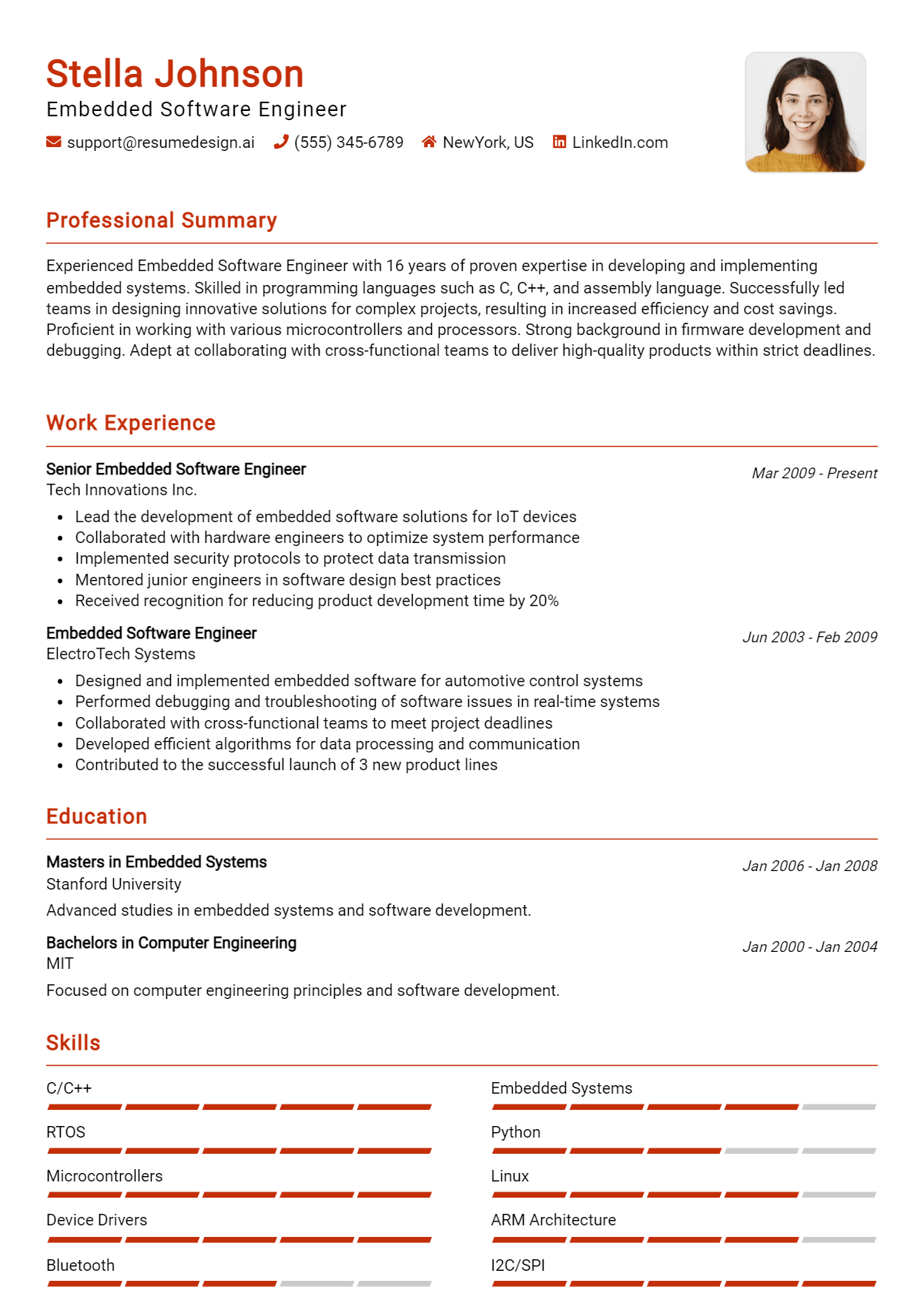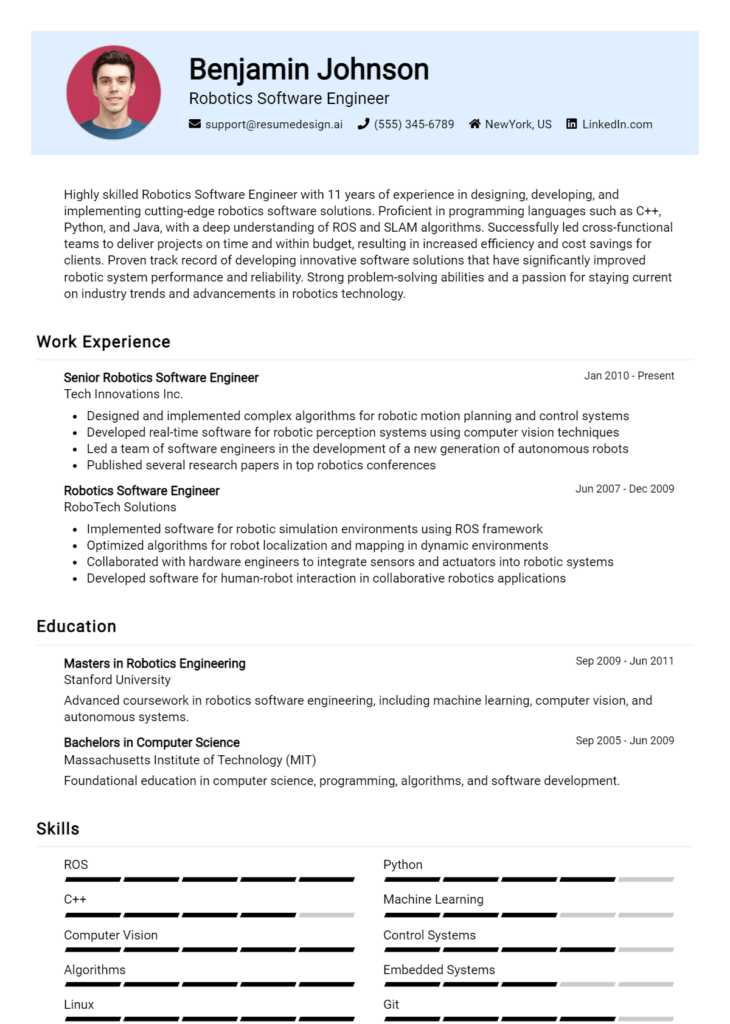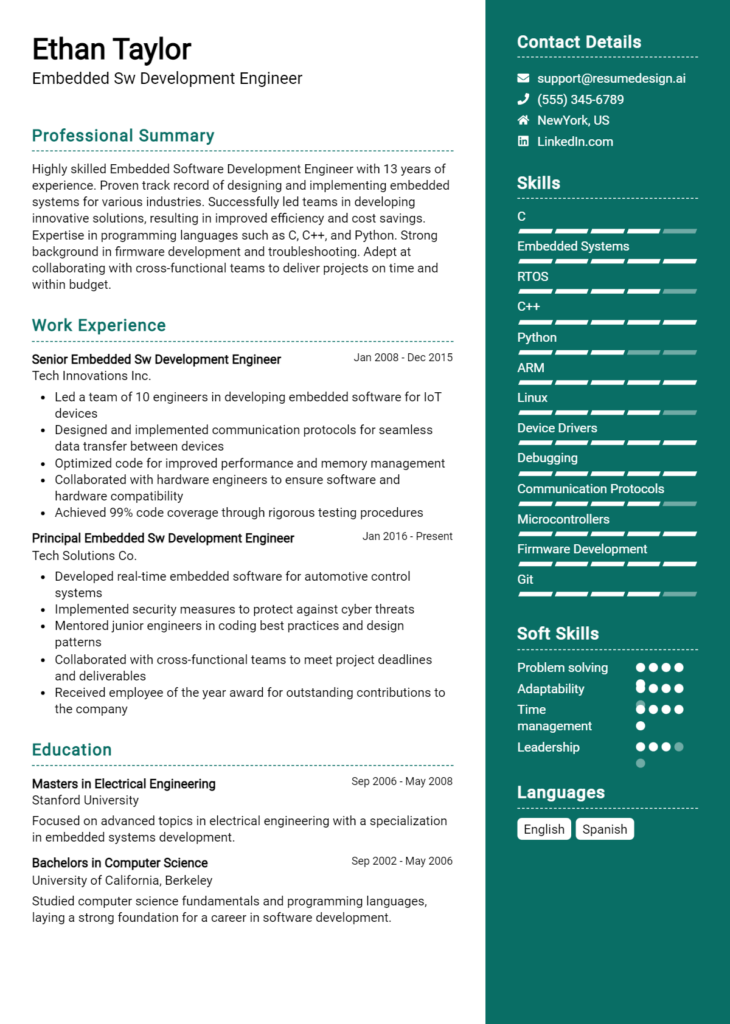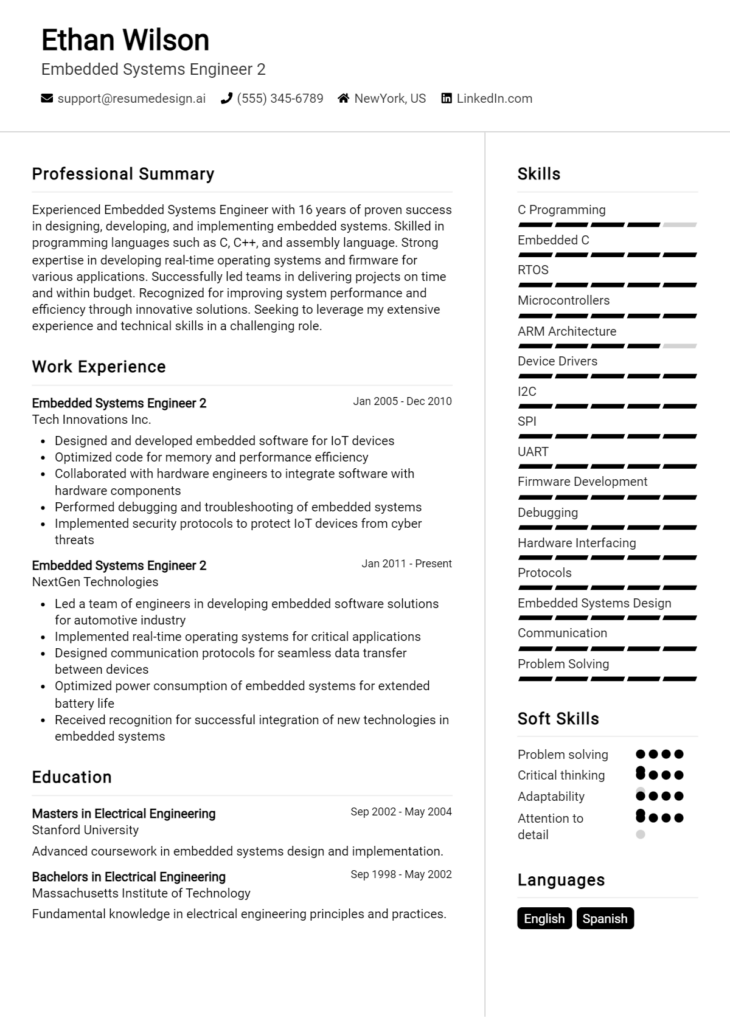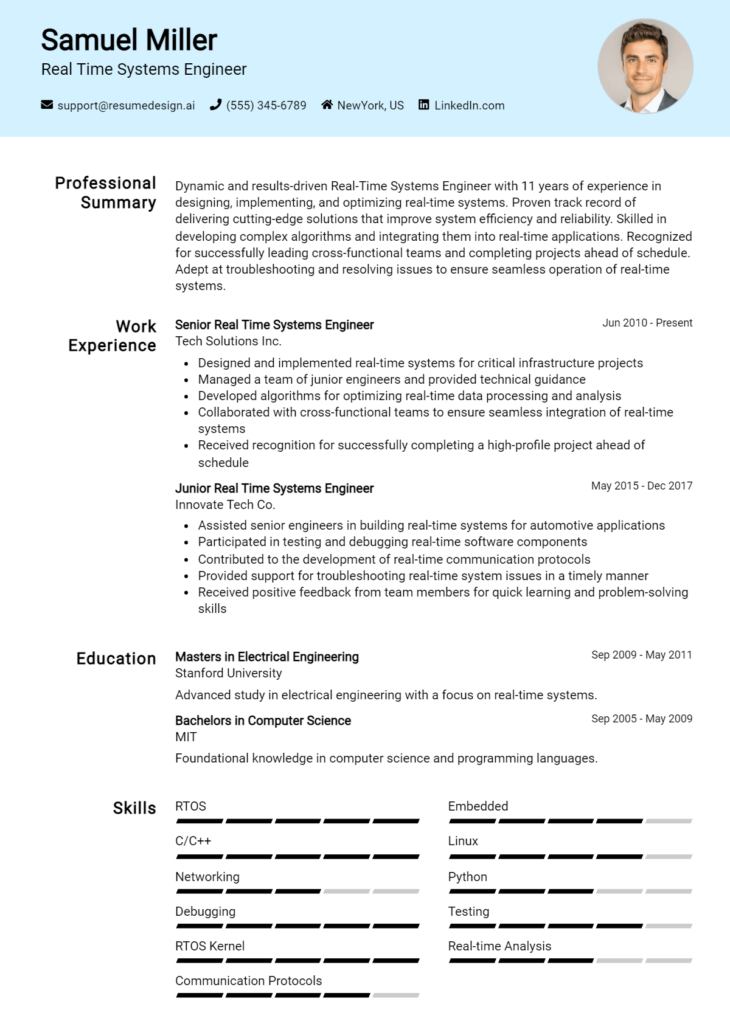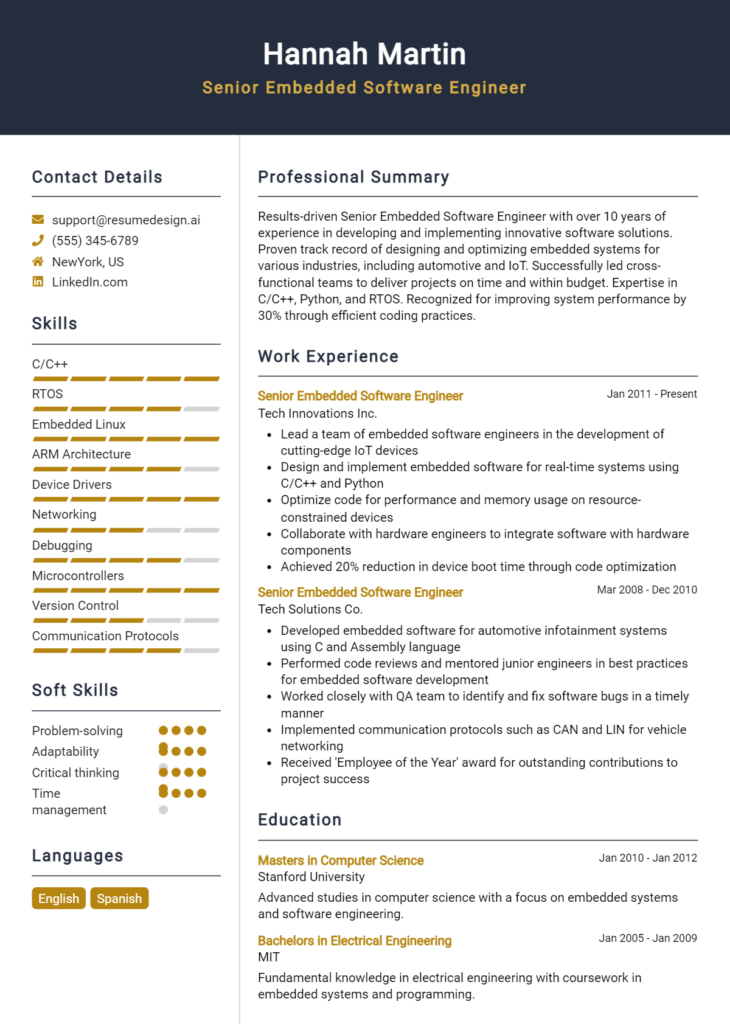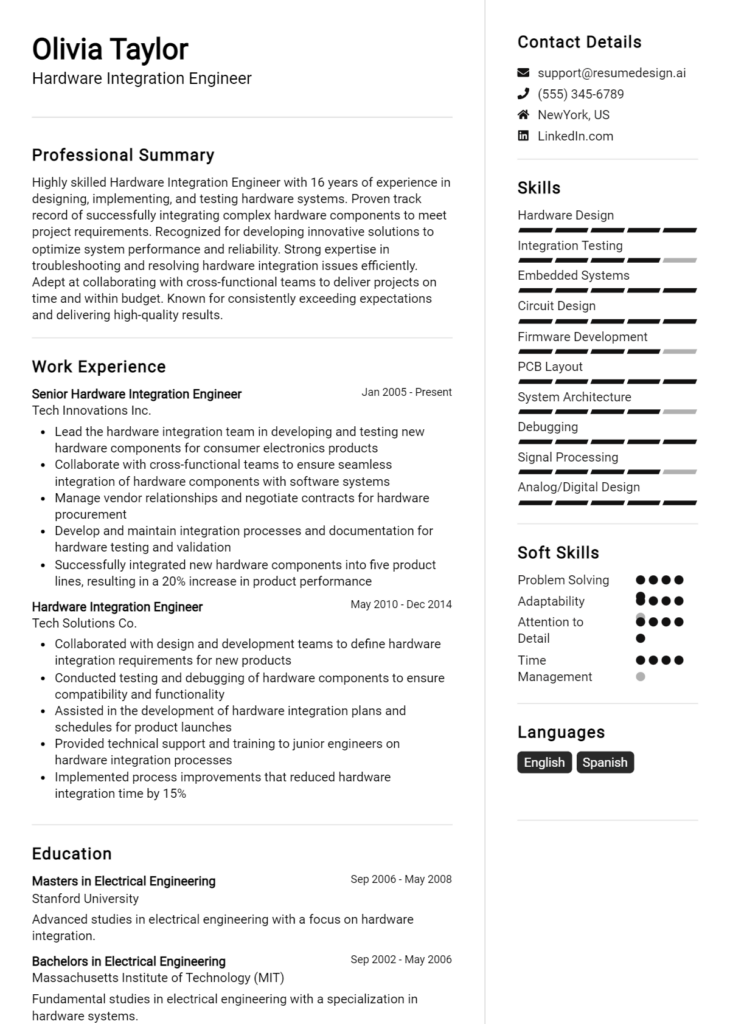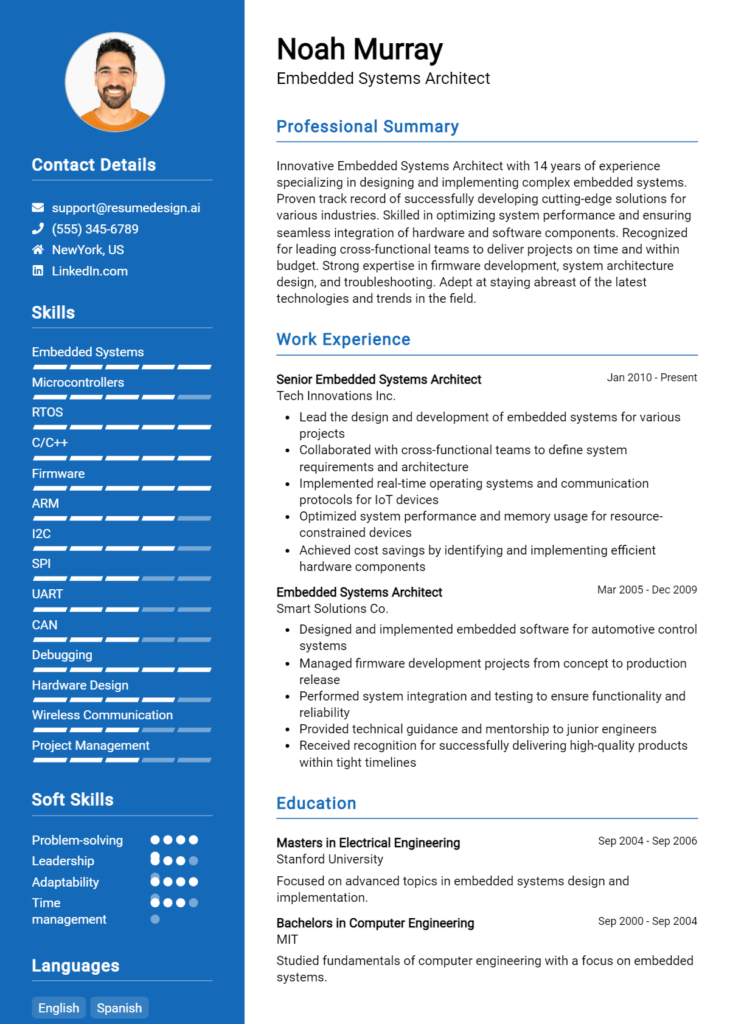Embedded Software Engineer Core Responsibilities
An Embedded Software Engineer plays a crucial role in developing, testing, and maintaining software for embedded systems, bridging the gap between hardware and software teams. Key responsibilities include designing algorithms, conducting code reviews, and optimizing system performance. Essential skills encompass technical proficiency in programming languages, operational knowledge of hardware interfaces, and strong problem-solving abilities. These competencies directly contribute to achieving organizational goals. A well-structured resume can effectively highlight these qualifications, showcasing the engineer’s impact on project success.
Common Responsibilities Listed on Embedded Software Engineer Resume
- Develop and implement embedded software applications.
- Conduct software testing and debugging to ensure system reliability.
- Collaborate with hardware engineers to integrate software and hardware components.
- Optimize software performance for real-time applications.
- Document software design specifications and maintenance procedures.
- Participate in code reviews and provide constructive feedback.
- Analyze user requirements and translate them into technical specifications.
- Maintain and improve existing software systems.
- Utilize version control systems for code management.
- Ensure compliance with industry standards and best practices.
- Work cross-functionally to troubleshoot and resolve issues.
High-Level Resume Tips for Embedded Software Engineer Professionals
A well-crafted resume is crucial for Embedded Software Engineer professionals, as it serves as the first impression a candidate makes on potential employers. In a competitive job market, your resume must not only showcase your technical skills but also highlight your achievements and project experiences that set you apart. A thoughtfully designed resume communicates your capabilities and demonstrates your fit for the role at a glance. In this guide, we will provide practical and actionable resume tips tailored specifically for Embedded Software Engineer professionals to help you create a compelling document that captures the attention of hiring managers.
Top Resume Tips for Embedded Software Engineer Professionals
- Tailor your resume to match the job description by including keywords and skills mentioned in the posting.
- Highlight relevant experience, focusing on projects that involved embedded systems, firmware development, or related technologies.
- Quantify your achievements with metrics, such as performance improvements, cost savings, or project completion times.
- Showcase industry-specific skills, including proficiency in programming languages like C, C++, and Python, as well as familiarity with tools like Git and debugging software.
- Include any certifications or training related to embedded systems, such as those from IEEE or specific vendor courses.
- Utilize a clean, professional format that is easy to read, ensuring your resume is visually appealing and well-organized.
- Incorporate a summary statement at the beginning that encapsulates your experience and career goals relevant to the embedded software domain.
- Highlight teamwork and collaboration experiences, as many embedded projects require cross-functional team efforts.
- Keep your resume to one or two pages; focus on the most relevant and impactful information.
By implementing these resume tips, you can significantly enhance your chances of landing a job as an Embedded Software Engineer. A tailored, achievement-focused resume will not only highlight your technical abilities but also demonstrate your value to potential employers, making you a standout candidate in this dynamic field.
Why Resume Headlines & Titles are Important for Embedded Software Engineer
In the competitive field of embedded software engineering, a well-crafted resume headline or title serves as the first impression a candidate makes on hiring managers. It plays a crucial role in immediately capturing attention and summarizing key qualifications in a succinct manner. A strong headline can communicate a candidate's expertise, relevant skills, and career focus in just a few impactful words, making it easier for recruiters to identify top talent. Therefore, crafting a concise, relevant, and job-specific headline is essential for standing out in a crowded job market.
Best Practices for Crafting Resume Headlines for Embedded Software Engineer
- Be concise: Aim for a headline that is clear and to the point, ideally no longer than a single phrase.
- Make it role-specific: Tailor your headline to the specific job you are applying for, using keywords from the job description.
- Highlight key skills: Include your most relevant technical skills or certifications that are pertinent to embedded software engineering.
- Showcase experience level: Indicate your years of experience or notable achievements that set you apart from other candidates.
- Use action-oriented language: Incorporate dynamic verbs that convey your proactive approach and contributions to past projects.
- Avoid clichés: Steer clear of overused phrases that do not add value, such as “hardworking” or “team player.”
- Reflect your personal brand: Ensure your headline aligns with how you want to be perceived in your professional domain.
- Revise for clarity: Edit your headline for clarity and impact, ensuring it communicates your value proposition effectively.
Example Resume Headlines for Embedded Software Engineer
Strong Resume Headlines
Innovative Embedded Software Engineer Specializing in IoT Solutions
Senior Embedded Developer with 10+ Years of Experience in Automotive Systems
Proficient Embedded Systems Engineer with Expertise in Real-Time Operating Systems
Results-Driven Embedded Software Engineer with a Track Record in High-Performance Applications
Weak Resume Headlines
Embedded Engineer
Software Developer
Seeking Engineering Position
Strong resume headlines are effective because they immediately convey the candidate's areas of expertise and significant accomplishments, allowing hiring managers to quickly assess their suitability for the role. They are specific, engaging, and tailored to the job, which makes them memorable. In contrast, weak headlines lack specificity and fail to provide any meaningful insight into the candidate's qualifications, making them easy to overlook. By avoiding generic titles, candidates can ensure their resumes stand out and resonate with potential employers.
Writing an Exceptional Embedded Software Engineer Resume Summary
A well-crafted resume summary is crucial for an Embedded Software Engineer as it serves as the first impression to hiring managers. This brief yet powerful section is designed to quickly capture attention by highlighting key skills, relevant experience, and notable accomplishments that align with the job role. A strong summary not only showcases a candidate's technical expertise but also their ability to contribute to the organization's goals. It should be concise, impactful, and tailored specifically to the job being applied for, ensuring that it resonates with the employer's needs.
Best Practices for Writing a Embedded Software Engineer Resume Summary
- Quantify Achievements: Use numbers and metrics to illustrate your impact, such as performance improvements or successful project completions.
- Focus on Relevant Skills: Highlight technical skills that are directly applicable to the job description, such as programming languages or software development methodologies.
- Tailor for the Job Description: Customize your summary to reflect the specific requirements and keywords found in the job listing.
- Keep it Concise: Aim for 2-4 sentences that clearly convey your strengths without overwhelming the reader.
- Highlight Key Accomplishments: Mention notable projects or contributions that demonstrate your expertise and effectiveness as an engineer.
- Showcase Problem-Solving Abilities: Include examples of challenges you've overcome or innovations you've contributed to that reflect your analytical skills.
- Use Strong Action Verbs: Start sentences with impactful verbs that convey your proactive approach and engagement in past roles.
- Maintain a Professional Tone: Ensure that the language used is professional yet approachable, reflecting your personality while adhering to industry standards.
Example Embedded Software Engineer Resume Summaries
Strong Resume Summaries
Results-driven Embedded Software Engineer with over 5 years of experience in developing high-performance firmware for automotive applications, achieving a 30% reduction in response time. Proficient in C/C++ and embedded systems, with a track record of delivering projects on time and within budget.
Detail-oriented Embedded Software Engineer skilled in real-time operating systems and digital signal processing, successfully leading a team to design a low-latency communication protocol that enhanced system efficiency by 25%. Recognized for innovative problem-solving and collaboration across multidisciplinary teams.
Accomplished Embedded Software Engineer with a strong foundation in IoT technologies, having contributed to the development of a smart home device that increased user engagement by 40%. Expertise in Python and Linux-based systems coupled with strong debugging and optimization skills.
Weak Resume Summaries
Embedded Software Engineer with experience in software development. Looking for a position where I can use my skills.
Motivated engineer with a background in electronics and software. I want to work in a challenging environment.
The examples of strong summaries are effective because they provide specific achievements, relevant skills, and quantifiable results that clearly demonstrate the candidate's capabilities. In contrast, the weak summaries lack detail and specificity, making them too generic and failing to showcase the candidate's unique qualifications or impact in their previous roles.
Work Experience Section for Embedded Software Engineer Resume
The work experience section of an Embedded Software Engineer resume is crucial as it serves as a vital showcase of the candidate's technical skills and abilities. This section not only highlights the candidate's proficiency in embedded systems but also demonstrates their capacity to manage teams and deliver high-quality products that meet industry standards. By quantifying achievements and aligning past experiences with the requirements of the role, candidates can effectively illustrate their impact and value to potential employers, making it an essential element of a compelling resume.
Best Practices for Embedded Software Engineer Work Experience
- Focus on specific technical skills relevant to embedded systems, such as C/C++, RTOS, and hardware interfacing.
- Quantify achievements where possible, using metrics to demonstrate the impact of your work (e.g., reduced processing time by 30%).
- Highlight leadership experiences, such as leading a project team or mentoring junior engineers.
- Include collaborative projects that showcase teamwork and cross-functional communication.
- Tailor your experience to align with the job description and industry standards.
- Use action verbs to convey a sense of initiative and accomplishment in your responsibilities.
- Describe the technologies and tools you utilized, emphasizing your hands-on experience.
- Keep descriptions concise and focused, avoiding jargon that may not be understood by all readers.
Example Work Experiences for Embedded Software Engineer
Strong Experiences
- Led a team of 5 engineers in the development of a real-time control system, resulting in a 40% increase in system efficiency and a successful deployment ahead of schedule.
- Designed and implemented an embedded firmware solution for a new IoT device, achieving a 25% reduction in power consumption compared to previous models.
- Collaborated with cross-functional teams to integrate hardware and software components, significantly improving product reliability and receiving the "Best Innovation" award from management.
Weak Experiences
- Worked on various software projects.
- Helped with debugging and testing of software.
- Participated in team meetings and discussions.
The strong experiences are considered effective because they provide specific results, demonstrate leadership, and illustrate collaboration, all while quantifying the impact of the candidate's contributions. In contrast, the weak experiences lack detail and measurable outcomes, failing to convey the candidate's skills, achievements, or the significance of their role in previous positions, making them less compelling to potential employers.
Education and Certifications Section for Embedded Software Engineer Resume
The education and certifications section of an Embedded Software Engineer resume plays a pivotal role in showcasing a candidate’s academic background and commitment to professional development. This section not only highlights the formal education obtained but also emphasizes industry-relevant certifications and specialized training that are essential for success in the field. By detailing relevant coursework and certifications, candidates can demonstrate their technical proficiency and alignment with job requirements, significantly enhancing their credibility in the eyes of potential employers. Continuous learning efforts, such as attending workshops or obtaining new certifications, further illustrate a proactive approach to staying updated in a rapidly evolving industry.
Best Practices for Embedded Software Engineer Education and Certifications
- Focus on relevant degrees such as Computer Engineering, Electrical Engineering, or Computer Science.
- Include industry-recognized certifications like Certified Embedded Systems Engineer (CESE) or similar qualifications.
- Detail relevant coursework that demonstrates specific skills in embedded systems, real-time programming, or hardware interfacing.
- Use a clear and concise format; ensure the most pertinent information is easily accessible to hiring managers.
- Highlight any specialized training or workshops attended, particularly those that align with emerging technologies.
- Update this section regularly to reflect new qualifications or skills acquired through continuous learning.
- Consider including GPA if it is impressive or if you are a recent graduate.
- List certifications in chronological order to show the progression of your qualifications.
Example Education and Certifications for Embedded Software Engineer
Strong Examples
- B.S. in Computer Engineering, XYZ University, 2022
- Certified Embedded Systems Engineer (CESE), 2023
- Relevant Coursework: Real-Time Operating Systems, Embedded C Programming, Microcontrollers.
- Completed specialized training in ARM Cortex-M Microcontroller Programming, 2023.
Weak Examples
- B.A. in Philosophy, ABC University, 2021
- Certification in Basic Computer Skills, 2019
- Relevant Coursework: Introduction to Psychology, Art History.
- Outdated certification in Windows 7 Administration, 2015
The strong examples are considered effective because they directly connect the candidate's education and certifications to the skills and knowledge required for the role of an Embedded Software Engineer. They feature relevant degrees, industry-recognized certifications, and coursework that aligns with the job requirements. In contrast, the weak examples lack relevance to the position, showcasing degrees and certifications that do not contribute to the candidate's qualifications in embedded systems, thereby diminishing their appeal to hiring managers.
Top Skills & Keywords for Embedded Software Engineer Resume
As an Embedded Software Engineer, having a well-crafted resume is crucial for standing out in a competitive job market. Employers often look for a specific set of skills that highlight both technical proficiency and personal attributes. A well-structured resume showcases these skills, presenting them in a way that aligns with the job requirements. Skills not only demonstrate your qualifications but also reflect your ability to adapt and collaborate effectively in a team environment. By emphasizing the right mix of hard and soft skills, you can better position yourself as a desirable candidate for an embedded software engineering role.
Top Hard & Soft Skills for Embedded Software Engineer
Soft Skills
- Problem-solving
- Critical thinking
- Communication
- Team collaboration
- Adaptability
- Time management
- Attention to detail
- Creativity
- Initiative
- Resilience
Hard Skills
- C/C++ programming
- Embedded systems design
- Real-time operating systems (RTOS)
- Microcontroller architecture
- Hardware-software integration
- Debugging and troubleshooting
- Knowledge of communication protocols (e.g., I2C, SPI, UART)
- Git version control
- Software development lifecycle (SDLC)
- Familiarity with embedded development tools (e.g., JTAG, oscilloscopes)
For more information about essential skills and how to effectively showcase your work experience on your resume, be sure to explore additional resources.
Stand Out with a Winning Embedded Software Engineer Cover Letter
I am writing to express my interest in the Embedded Software Engineer position at [Company Name], as advertised on [Job Board/Company Website]. With a Bachelor's degree in Computer Engineering and over [X years] of hands-on experience in developing and optimizing embedded systems, I am excited about the opportunity to contribute to your team. My background in C/C++ programming, real-time operating systems, and hardware-software integration aligns well with the requirements of this role, and I am particularly drawn to [Company Name] due to its commitment to innovation and quality in embedded solutions.
In my previous role at [Previous Company Name], I successfully led the development of a critical embedded system for [specific project or application], which involved collaboration with cross-functional teams to ensure seamless integration and performance optimization. My expertise in debugging and troubleshooting embedded software, coupled with my knowledge of communication protocols such as SPI, I2C, and UART, enabled me to enhance system reliability and achieve a [specific measurable outcome, e.g., "20% reduction in response time"]. I am proficient in using tools like [specific tools or software relevant to the job], which I believe will allow me to make an immediate impact on your projects at [Company Name].
I am particularly impressed by [specific project or initiative of the company], and I am eager to bring my skills in embedded software design and development to contribute to similar innovative projects. Additionally, my strong communication skills and ability to work collaboratively in a team environment will help foster productive relationships with other engineers and stakeholders. I am passionate about staying updated with the latest industry trends and technologies, and I am committed to continuous learning and improvement in my field.
Thank you for considering my application. I am looking forward to the opportunity to discuss how my expertise can contribute to the continued success of [Company Name]. I am excited about the possibility of joining your talented team and working on cutting-edge embedded systems that drive technological advancement. Please feel free to contact me at your earliest convenience to schedule a conversation.
Common Mistakes to Avoid in a Embedded Software Engineer Resume
When crafting a resume for an Embedded Software Engineer position, it's crucial to present your skills and experience effectively to stand out among the competition. However, many candidates make common mistakes that can hinder their chances of landing an interview. Avoiding these pitfalls will not only enhance the clarity of your resume but also showcase your qualifications in the best light possible.
Lack of Specificity in Technical Skills: Simply listing "C" or "Embedded Systems" without specifying the version, frameworks, or projects can make your skills seem generic. Be detailed about which platforms and tools you have experience with.
Ignoring Relevant Experience: Some candidates focus solely on their most recent job and fail to include relevant past experiences. Highlighting internships, projects, or coursework can provide a more comprehensive view of your capabilities.
Using a One-Size-Fits-All Approach: Sending the same resume for every application can be detrimental. Tailor your resume to each job description to emphasize the skills and experiences that align with the specific role.
Neglecting Soft Skills: While technical expertise is critical, soft skills like teamwork, communication, and problem-solving are equally important in embedded systems projects. Make sure to showcase these competencies in your resume.
Overloading with Jargon: Using excessive technical jargon or acronyms without explanation can confuse hiring managers. Ensure that your resume is accessible to both technical and non-technical reviewers by providing context where necessary.
Poor Formatting and Structure: A cluttered or unorganized resume can be off-putting. Use clear headings, bullet points, and consistent formatting to make it easy for recruiters to navigate your qualifications.
Failing to Quantify Achievements: Stating responsibilities without quantifying your accomplishments can diminish the impact of your experience. Use metrics to demonstrate how your contributions led to improvements or success in projects.
Omitting Keywords: Many companies use Applicant Tracking Systems (ATS) to filter resumes. Failing to incorporate relevant keywords from the job description can result in your resume being overlooked. Be sure to include pertinent terms that align with the job requirements.
Conclusion
As an Embedded Software Engineer, your expertise in developing software for hardware systems is crucial in various industries, from automotive to consumer electronics. Throughout this article, we explored the essential skills that define a successful Embedded Software Engineer, including proficiency in programming languages like C and C++, familiarity with microcontrollers, and a strong understanding of real-time operating systems. Additionally, we discussed the importance of problem-solving abilities, teamwork, and continuous learning in this fast-evolving field.
To ensure that your qualifications and experiences stand out in the competitive job market, it's vital to have an updated and well-crafted resume. Take a moment to review your Embedded Software Engineer resume to ensure it accurately reflects your skills, projects, and achievements.
To assist you in this process, consider utilizing the following resources:
- Explore a variety of resume templates tailored for technical positions.
- Use the resume builder for a user-friendly experience in creating your professional document.
- Check out resume examples to gain inspiration and see what works best for your profile.
- Don't forget about the importance of a strong first impression—browse our cover letter templates to complement your resume effectively.
Now is the time to take action and refine your resume to showcase your abilities as an Embedded Software Engineer. Your next career opportunity could be just around the corner!

